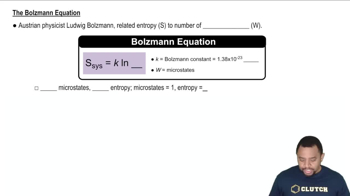Here are the essential concepts you must grasp in order to answer the question correctly.
Boltzmann's Equation
Boltzmann's equation relates the entropy (S) of a system to the number of microstates (W) that correspond to a given macrostate. It is expressed as S = k * ln(W), where k is the Boltzmann constant. This equation highlights the connection between the microscopic behavior of particles and the macroscopic property of entropy, emphasizing that greater disorder (more microstates) leads to higher entropy.
Recommended video:
Microstates and Macrostates
In statistical mechanics, a microstate refers to a specific arrangement of particles in a system, while a macrostate is defined by macroscopic properties like temperature and pressure. The number of microstates corresponding to a macrostate determines the entropy of that state. Understanding how to count microstates is crucial for calculating the entropy of different distributions of gas molecules.
Recommended video:
Combinatorial Counting
Combinatorial counting is a mathematical technique used to determine the number of ways to arrange or distribute objects. In the context of gas molecules in bulbs, it involves calculating the different ways to distribute a set number of molecules across multiple containers. This concept is essential for finding the number of microstates (W) for each scenario, which is then used in Boltzmann's equation to find the entropy.
Recommended video:
Significant Figures Example
 McMurry 8th Edition
McMurry 8th Edition Ch.18 - Thermodynamics: Entropy, Free Energy & Equilibrium
Ch.18 - Thermodynamics: Entropy, Free Energy & Equilibrium Problem 50
Problem 50 Verified step by step guidance
Verified step by step guidance


